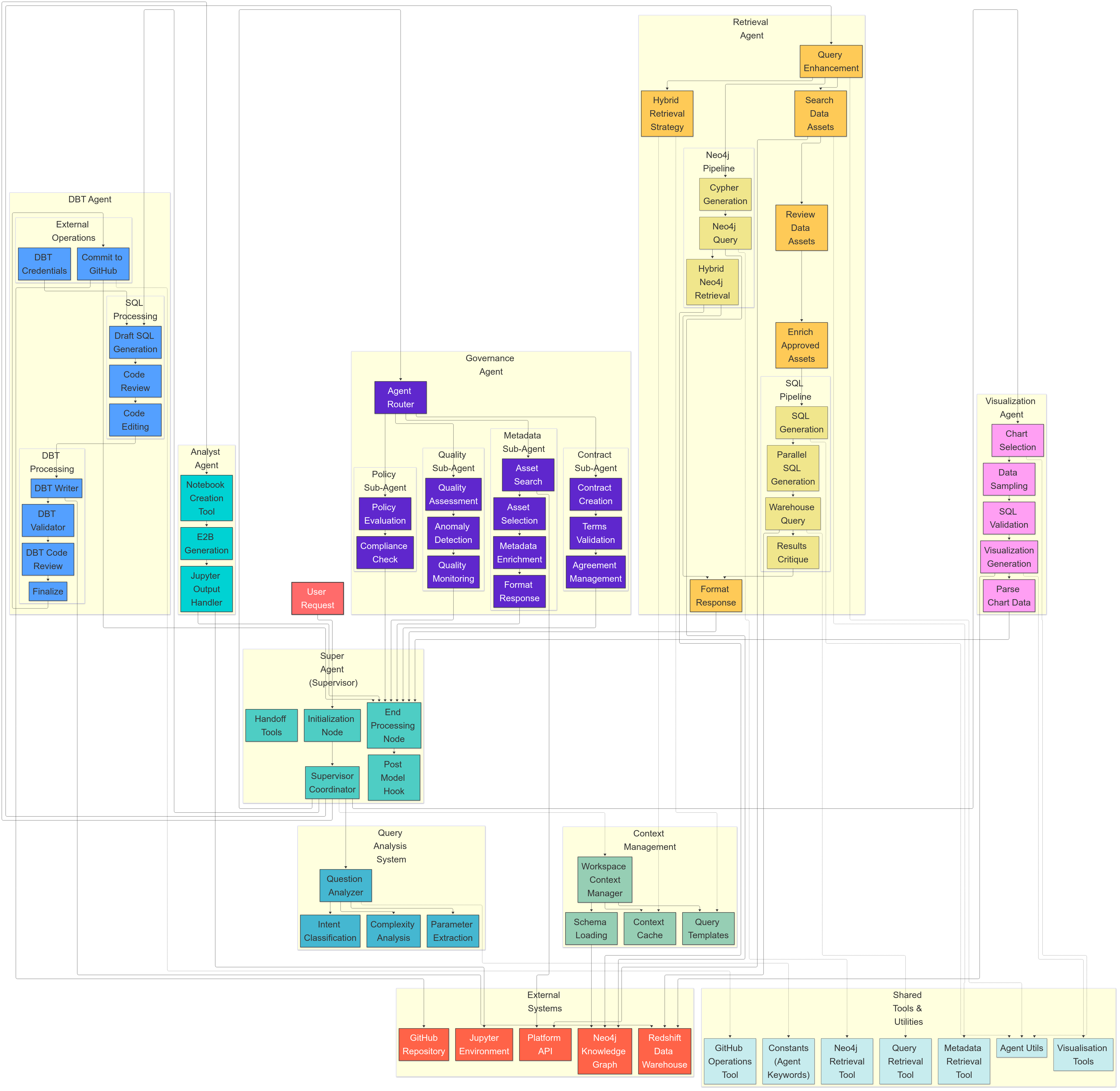Skip to main contentSystem Overview
BrightAgent is a comprehensive multi-agent AI system designed for end-to-end data management and analytics. The architecture enables natural language interactions with your data through specialized agents that handle the different aspects of the data lifecycle.
Core Components
🎯 Main Agent & Orchestration
- Supervisor Agent: Central orchestrator that receives user queries and routes them to appropriate specialized agents
- BrightAgent API: Primary interface for user interactions and system communication
- Query Processing: Natural language understanding and intent classification
🤖 Specialized Agent Ecosystem
Data Processing Agents
- Retrieval Agent: Implements RAG (Retrieval Augmented Generation) for intelligent data fetching
- Engineering Agent: Handles data transformation, dbt code generation, and data pipeline management
- Analytics Agent: Performs statistical analysis and generates Jupyter notebooks with insights
- Visualization Agent: Creates interactive charts, dashboards, and visual representations
Intelligence & Governance
- Governance Agent: Ensures data quality, compliance, and security across all operations
- TEI Agent: Text Embedding Interface for semantic understanding and vector operations
- Context Management: Maintains session state and cross-agent communication
🗄️ Data Infrastructure
Knowledge Systems
- Knowledge Graph: Structured representation of relationships and metadata
- Data Catalog: Comprehensive inventory of available data assets and their properties
- Vector Store: Semantic search and embedding storage for intelligent retrieval
External Integrations
- Data Sources: Databases, APIs, file systems, and streaming platforms
- Warehouse Integration: Connection to modern data warehouses (Snowflake, BigQuery, etc.)
- Third-party Tools: Integration with existing data stack components
Data Flow Architecture
1. Query Initiation
2. Agent Coordination
- Parallel Processing: Multiple agents can work simultaneously on different aspects
- Context Sharing: Agents share relevant context and intermediate results
- Quality Assurance: Built-in validation and review processes
3. Response Generation
- Multimodal Output: Jupyter notebooks, visualizations, code, and text responses
- Interactive Elements: Dashboards with real-time data connections
- Actionable Insights: Recommendations and next steps for users
Key Architectural Principles
🔄 Event-Driven Design
- Asynchronous agent communication
- Real-time data processing capabilities
- Scalable message handling
🛡️ Security & Governance
- Role-based access control across all agents
- Data lineage tracking throughout the pipeline
- Automated compliance monitoring
- Intelligent caching strategies
- Resource pooling and load balancing
- Optimized query execution paths
🔌 Extensibility
- Plugin architecture for custom agents
- API-first design for external integrations
- Configurable workflows and business rules
Agent Interaction Patterns
Sequential Processing
Some workflows require step-by-step execution:
e.g. Retrieval → Engineering → Analytics → Visualization
Parallel Processing
Other tasks can be handled simultaneously:
e.g. Data Quality Checks (Governance) + Data Retrieval + Visualization Prep
Feedback Loops
Continuous improvement through:
- Quality feedback from Governance Agent to other agents
- Performance metrics influencing future query routing
- User feedback refining agent responses
Deployment Architecture
Cloud-Native Design
- Containerized agent deployment
- Auto-scaling based on workload
- Multi-zone availability
Edge Computing
- Local processing for sensitive data
- Reduced latency for real-time analytics
- Hybrid cloud-edge orchestration
This architecture enables BrightAgent to function as a comprehensive “data team in a box,” providing expert-level capabilities across the entire data lifecycle while maintaining security, performance, and ease of use. 

